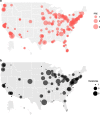The 2019 US medical genetics workforce: a focus on clinical genetics
- PMID: 33941882
- PMCID: PMC8091643
- DOI: 10.1038/s41436-021-01162-5
The 2019 US medical genetics workforce: a focus on clinical genetics
Abstract
Purpose: This study characterizes the US clinical genetics workforce to inform workforce planning and public policy development.
Methods: A 32-question survey was electronically distributed to American Board of Medical Genetics and Genomics board-certified/eligible diplomates in 2019. We conducted a descriptive analysis of responses from practicing clinical geneticists.
Results: Of the 491 clinical geneticists responding to the survey, a majority were female (59%) and White (79%), worked in academic medical centers (73%), and many engaged in telemedicine (33%). Clinical geneticists reported an average of 13 new and 10 follow-up patient visits per week. The average work week was 50 hours and the majority (58%) worked over half-time in clinical duties. Providers indicated that 39% of new emergency patients wait 3 days or more, and 39% of nonemergency patients wait over 3 months to be seen. Respondents were geographically concentrated in metropolitan areas and many reported unfilled clinical geneticist job vacancies at their institution of more than 3 years.
Conclusion: With the rapid expansion of genomic medicine in the past decade, there is still a gap between genetics services needed and workforce capacity. A concerted effort is required to increase the number of clinical geneticists and enhance interdisciplinary teamwork to meet increasing patient needs.
© 2021. The Author(s).
Conflict of interest statement
The authors declare no competing interests.
Figures
Comment in
-
Become an ambassador to recruit the next generation in genomic medicine.Genet Med. 2022 Jan;24(1):26-28. doi: 10.1016/j.gim.2021.08.001. Epub 2021 Nov 30. Genet Med. 2022. PMID: 34906451 No abstract available.
References
Publication types
MeSH terms
LinkOut - more resources
Full Text Sources
Other Literature Sources
Miscellaneous


